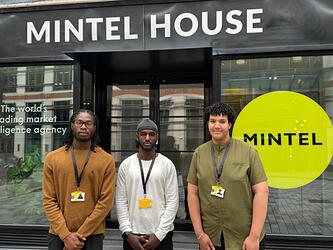Bias in the spotlight: inattentional blindness
Did you notice anything unusual?
- In the first photograph, did you see that the woman has too many fingers on her left hand?
- In the second photograph, did you spot the phantom arm resting on the man’s shoulder?
- In the third photograph, did you notice that the man has only one ear?
The Colgate campaign, run by Y&R Brazil in 2012 was designed to make us feel that when we have food stuck in our teeth it has such a powerful impact on others that they notice very little else about us, even a major physical defect like those in the images above. The copy on each ad reads:
“Not even that [insert anatomical oddity] gets more attention than a mouth without care.”
This ad sequence is an example of inattentional blindness: when people focus on a particular task that demands their attention, they often fail to notice a fully visible, but unexpected object or event that occurs in full view. People often do not consciously perceive aspects in their surroundings that fall outside of their focus of attention. Tasks can be based around a static scene or a set of images — as Colgate uses here — or around a more dynamic scenario.
An example of a dynamic scenario is the ‘Invisible gorilla’ experiment developed by Daniel Simons and Christopher Chabris in 1999, which is frequently used to illustrate inattentional blindness. If you’ve not seen it, don’t read any further, but watch and test yourself here.
Most people are so focused on counting the number of basketball passes that they fail to notice the man in a gorilla suit waltzing onto the screen.
Ask them in advance and most people would feel confident of their ability to spot a gorilla in film footage of a basketball game, or the presence of extra limbs in the photograph of a couple. The experiments demonstrate how little control we actually have of where our attention focuses and where it is blind.
Inattentional blindness has big implications for several activities:
- A major one is driving — most accidents occur due to human error — and many are due to distracted driving. If we are too focused on something else while driving, perhaps we’re checking directions and thinking too hard about where we are going, or we’re concentrating on a conversation in the car or on a hands-free phone conversation, each of these distractions makes us less likely to notice a child stepping into the road or the car ahead braking suddenly.
- Another implication is for the reliability of witness statements as evidence in crime cases. Memory alone is fallible, but inattentional blindness shows that we might not even notice a criminal act being committed if our attention is elsewhere, but we could still be convinced that if such an act had occurred we could not have failed to notice it.
Of course, the magician or con artist is dependent on people’s inattentional blindness. Their tricks rely on getting our attention focused on something else in order to blind us to their sleight of hand. Often, what lies behind the success of the magic or the con is simply our failure to pay attention…

We hope you enjoyed this article.
Research Live is published by MRS.
The Market Research Society (MRS) exists to promote and protect the research sector, showcasing how research delivers impact for businesses and government.
Members of MRS enjoy many benefits including tailoured policy guidance, discounts on training and conferences, and access to member-only content.
For example, there's an archive of winning case studies from over a decade of MRS Awards.
Find out more about the benefits of joining MRS here.












0 Comments